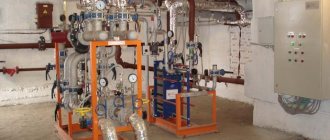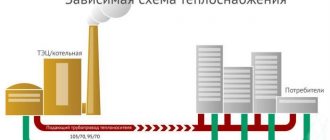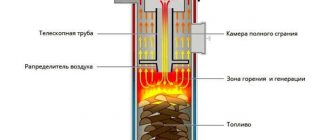Among alternative sources, geothermal energy occupies a significant place - it is used in one way or another in about 80 countries around the world. In most cases, this occurs at the level of construction of greenhouses, swimming pools, use as a remedy or heating.
In several countries - including the USA, Iceland, Italy, Japan and others - power plants have been built and are operating.
Geothermal energy is broadly classified into two types – petrothermal and hydrothermal. The first type uses hot rocks as a source. The second is groundwater.
If you combine all the data on the topic into one diagram, you will find that in 99% of cases the heat of rocks is used, and only in 1% geothermal energy is extracted from groundwater.
Petrothermal energy
At the moment, the world uses the heat of the earth's interior quite widely, and mainly this is the energy of shallow wells - up to 1 km. In order to provide electricity, heat or hot water, downhole heat exchangers are installed that operate on liquids with a low boiling point (for example, freon).
Nowadays, the use of a borehole heat exchanger is the most rational way to produce heat. It looks like this: the coolant circulates in a closed circuit. The heated one rises through a concentrically lowered pipe, giving off its heat, after which, cooled, it is fed into the casing using a pump.
The use of the energy of the earth's interior is based on a natural phenomenon - as one approaches the Earth's core, the temperature of the earth's crust and mantle increases. At a level of 2-3 km from the surface of the planet, it reaches more than 100 °C, increasing on average by 20 °C with each subsequent kilometer. At a depth of 100 km, the temperature already reaches 1300–1500 ºС.
Further potential
The accumulated basis of knowledge and practice becomes the foundation for future achievements. It is too early to talk about complete replacement of traditional reserves, since thermal zones and methods of extracting energy resources have not been fully studied. For faster development, more attention and financial investments are required.
While society is becoming familiar with the possibilities, it is slowly moving forward. According to expert estimates, only 1% of the world's electricity is produced by this fund. It is possible that comprehensive programs for the development of the industry at the global level will be developed, mechanisms and means of achieving goals will be worked out. Subsoil energy can solve the environmental problem, because every year there are more harmful emissions into the atmosphere, the oceans are polluted, and the ozone layer becomes thinner. For the rapid and dynamic development of the industry, it is necessary to remove the main obstacles, then in many countries it will become a strategic springboard, capable of dictating conditions in the market and raising the level of competitiveness.
Hydrothermal energy
Water circulating at great depths heats up to significant levels. In seismically active areas, it rises to the surface through cracks in the earth's crust, while in calm regions it can be brought out using wells.
The principle of operation is the same: heated water rises up the well, gives off heat, and returns down the second pipe. The cycle is almost endless and is renewed as long as there is heat in the bowels of the earth.
In some seismically active regions, hot water lies so close to the surface that you can see first-hand how geothermal energy works. A photo of the surroundings of the Krafla volcano (Iceland) shows geysers that transmit steam for the geothermal power plant operating there.
A little history
The idea of using the collected steam from geothermal sources was first expressed at the beginning of the 19th century by the French engineer and entrepreneur Francois de Larderel.
The world's first GeoPP in Larderello
Almost 100 years later, in 1904, Italian businessman Piero Conti tested a geothermal generator for the first time in the town of Larderello. There, seven years later, the world’s first geothermal power plant (GeoPP) was launched, which, by the way, is still operating today.
Piero Conti and his geothermal generator
Main features of geothermal energy
Attention to alternative sources is due to the fact that oil and gas reserves on the planet are not endless, and are gradually being exhausted. In addition, they are not available everywhere, and many countries depend on supplies from other regions. Other important factors include the negative impact of nuclear and fuel energy on the human environment and wildlife.
The great advantage of hydroelectric power is its renewability and versatility: the ability to be used for water and heat supply, or for electricity generation, or for all three purposes at once.
But the main thing is geothermal energy, the pros and cons of which depend not so much on the location as on the customer’s wallet.
Internal energy of the Earth
It appeared as a result of several processes, the main ones being accretion and radioactivity. According to scientists, the formation of the Earth and its mass occurred over several million years, and this happened due to the formation of planetesimals. They stuck together, and accordingly, the mass of the Earth became more and more. After our planet began to have its modern mass, but was still devoid of an atmosphere, meteoroid and asteroid bodies fell unhindered on it. This process is precisely called accretion, and it led to the release of significant gravitational energy. And the larger the bodies that hit the planet, the greater the volume of energy contained in the bowels of the Earth.
This gravitational differentiation led to the fact that substances began to stratify: heavy substances simply sank, while light and volatile ones floated up. Differentiation also affected the additional release of gravitational energy.
Advantages and disadvantages of GE
The advantages of this type of energy include the following:
- it is renewable and practically inexhaustible;
- independent of the time of day, season, weather;
- universal - it can be used to provide water and heat supply, as well as electricity;
- geothermal energy sources do not pollute the environment;
- do not cause a greenhouse effect;
- stations do not take up much space.
However, there are also disadvantages:
- geothermal energy is not considered completely harmless due to steam emissions, which may contain hydrogen sulfide, radon and other harmful impurities;
- when using water from deep horizons, there is a question of its disposal after use - due to the chemical composition, such water must be drained either back into the deep layers or into the ocean;
- building a station is relatively expensive - this increases the cost of energy as a result.
New time - new ideas
Of course, people do not stop there, and every year more and more attempts are made to find new ways to obtain energy. If the earth's heat energy is obtained quite simply, then some methods are not so simple. For example, it is quite possible to use biological gas, which is obtained by rotting waste, as an energy source. It can be used for heating houses and heating water.
Increasingly, tidal power plants are being built, when dams and turbines are installed across the mouths of reservoirs, which are driven by the ebb and flow of the tides, respectively, producing electricity.
Agriculture and Horticulture
Most often, the use of geothermal energy in agriculture comes down to heating and watering greenhouses, greenhouses, and aqua and hydroculture installations. A similar approach is used in several countries - Kenya, Israel, Mexico, Greece, Guatemala and Teda.
Underground sources are used for watering fields, heating the soil, maintaining constant temperature and humidity in a greenhouse or greenhouse.
Brief conclusions
- The growth dynamics of renewable energy sources around the world is positive, amounting to about 20% annually over the past 10-15 years.
- Energy from alternative renewable sources is becoming cheaper. Already today, in many regions of the world, using one or another type of fuel is more profitable than traditional types of fuel.
- Renewable energy guarantees the fundamental impossibility of depleting its reserves.
- The transition to renewable energy sources has a beneficial effect on the environment. This is especially noticeable in large cities and the most polluted regions of the planet.
- In the long term, a complete transition away from fossil fuels could save the planet more than $13.8 trillion a year in medical costs alone. First of all, this relates to a radical reduction in diseases of the upper respiratory tract, circulatory system, as well as the development of cancer.
Industry and housing and communal services
In November 2014, the world's largest geothermal power plant at the time began operating in Kenya. The second largest is in Iceland - this is Hellisheidi, which takes heat from sources near the Hengidl volcano.
Other countries using geothermal energy on an industrial scale: USA, Philippines, Russia, Japan, Costa Rica, Turkey, New Zealand, etc.
There are four main schemes for generating energy from geothermal power plants:
- direct, when steam is directed through pipes to turbines connected to electric generators;
- indirect, similar to the previous one in everything, except that before entering the pipes, the steam is cleared of gases;
- binary - not water or steam is used as working heat, but another liquid with a low boiling point;
- mixed - similar to direct, but after condensation, undissolved gases are removed from the water.
In 2009, a team of researchers searching for exploitable geothermal resources reached molten magma at a depth of just 2.1 km. Such a hit in magma is very rare; this is only the second known case (the previous one occurred in Hawaii in 2007).
Although the pipe connected to the magma has never been connected to the nearby Krafla Geothermal Power Plant, scientists have obtained very promising results. Until now, all operating stations have taken heat indirectly, from earth rocks or groundwater.
Power generation
Hot springs and geysers serve as the main components in the production of electricity. For this purpose, several schemes are used, and special power plants are built. GTS device:
- DHW tank
- Pump
- Gas separator
- Steam separator
- Generating turbine
- Capacitor
- Boost pump
- Tank-cooler
As we can see, the main element of the circuit is the steam converter. This allows you to obtain purified steam, since it contains acids that destroy turbine equipment. It is possible to use a mixed scheme in the technological cycle, that is, water and steam are involved in the process. The liquid goes through the entire stage of purification from gases, just like steam.
Private sector
One of the most promising areas is the private sector, for which geothermal energy is a real alternative to autonomous gas heating. The most serious obstacle here is the high initial cost of the equipment, which is quite cheap to operate, which is significantly higher than the price of installing “traditional” heating.
MuoviTech, Geodynamics Ltd, Vaillant, Viessmann, Nibe offer their developments for the private sector.
Calculations
The main parameters that are taken into account in any calculations are:
- temperature (depths from 15-20 m or more warm up from 8 to 100 degrees, depending on the conditions);
- extracted power value (average value - 0.05 kW per 1 m);
- the influence of climate, humidity and contact with groundwater on heat transfer.
Interesting Current problem
What is very interesting is that completely dry rocks emit no more than 25 W per 1 m, and if there is groundwater, this figure rises to 100-110 W. We must not forget that the standard operating time of a heat pump is 1800 hours per year. If you exceed this figure, the system will not become more efficient, but its wear will rapidly increase. What is much worse, excessive exploitation of the thermal resource of the subsoil leads to its cooling and even to the freezing of rocks at the working depth. Following this, the soil may subsidence, sometimes damaging working pipes and above-ground structures.
Countries using the planet's heat
The undisputed leader in the use of georesources is the United States - in 2012, energy production in this country reached 16.792 million megawatt-hours. In the same year, the total capacity of all geothermal stations in the United States reached 3386 MW.
Geothermal power plants in the United States are located in the states of California, Nevada, Utah, Hawaii, Oregon, Idaho, New Mexico, Alaska and Wyoming. The largest group of factories is called “Geysers” and is located near San Francisco.
In addition to the United States, other countries in the top ten (as of 2013) are the Philippines, Indonesia, Italy, New Zealand, Mexico, Iceland, Japan, Kenya and Turkey. At the same time, in Iceland, geothermal energy sources provide 30% of the country’s total needs, in the Philippines - 27%, and in the USA - less than 1%.
Heating process
The water temperature is 50 -60 degrees, which is optimal for heating and hot supply of residential areas. The need for heating systems depends on the geographical location and climatic conditions. And people constantly need hot water supply. For this process, GTS (geothermal thermal stations) are constructed.
If for the classic production of thermal energy a boiler house is used that consumes solid or gas fuel, then in this production a geyser source is used. The technical process is very simple, the same communications, thermal routes and equipment. It is enough to drill a well, clean it of gases, then send it with pumps to the boiler room, where the temperature schedule will be maintained, and then it will enter the heating main.
The main difference is that there is no need to use a fuel boiler. This significantly reduces the cost of thermal energy. In winter, subscribers receive heat and hot water supply, and in summer only hot water supply.











